Lo Nuevo[hide]
Musicos: Dennis Nicles Cobas
Fotos: Eli Silva
Grupos: Ritmo Oriental : 1988 - Vol. IX - 30 a...
Musicos: Rafael Paseiro Monzón
Musicos: Jiovanni Cofiño Sánchez
Fotos: Tom Ehrlich : 2024 Monterey Jazz, P...
Resenas: Vacilón Santiaguero (Circle 9 ...
Staff: Bill Tilford
Fotos: Tom Ehrlich : 2024 Monterey Jazz, P...
Fotos: Tom Ehrlich : 2024 Monterey Jazz Fe...
Fotos: Tom Ehrlich : testing 123
Grupos: Pupy y los que S... : Discography - 1995- F...
Reportes: From The St... : Cubadisco 2...
Reportes: From The St... : Jazz Plaza ...
Fotos Del Día [hide]
SpanishEnglishJuan Carlos González - History of Charanga Habanera
Introducción: Juan Carlos González es una de las figuras más importantes en la historia de la música cubana, y la fuerza musical del éxito del conjunto original llamado "La Charanga Habanera." En la primera parte, él cuenta sobre los primeros años del conjunto, llevándolos al éxito fenomenal de los primeros discos. Explica algunas de sus razones por haberse ido del conjunto también. La segunda parte, que no tarda en llegar, cubrirá el último año, la famosa "suspensión" por el gobierno cubano, y su carrera hasta el día de hoy, incluyendo su trabajo con Dany Lozada, La Charanga Forever y otros.
La verdadera historia de La Charanga Habanera, parte 1
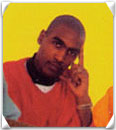
por Juan Carlos González
según fue contada a Majela Serrano
©2001
La Charanga Habanera fue una agrupación creada en el año 1988 por encargo del señor Bernard Lion, que se ocupaba de la dirección general de los espectáculos en el Sporting Club de Mónaco, Montecarlo. El repertorio consistía en música netamente tradicional cubana (danzones, cha cha chá, mambo, bolero, guaracha, son); cualquier género que se hubiese hecho antes del 59.
Este año, la orquesta se conformó por muy buenos músicos, pero muy mayores para los intereses estéticos del cabaret. Para el próximo año, casi todos los integrantes fueron renovados, incluyendo al director, Gerardo Aguillón, violinista de Santiago de Cuba. Sólo se mantuvieron David Calzado (violinista) y Jorge Emilio Maza (flautista).
Yo me encontraba trabajando en “ Los violines de Tropicana ” como violista y fui reclutado junto a Pedro César Fajardo (violinista), para formar parte de la Charanga a partir de 1989, dirigida por el maestro José Picayo, el pianista de la orquesta.
El trabajo en Montecarlo era bastante duro, e intenso, pues teníamos que cambiar de repertorio semanalmente, el cual incluía una primera parte de más de 1 hora y media de música “de fondo” para acompañar la comida; y después hacíamos una parte bailable como cortina del show ( fue aquí donde hicimos cortina a la gran mayoría de las estrellas más relevantes del mundo entero). Debido a la extensión del programa, se hacía casi imposible para un sólo arreglista hacer este trabajo, y fue entonces que yo empecé como arreglista activo de la orquesta. David Calzado hizo por aquellos tiempos el arreglo del tema “Aquellos ojos verdes”, bajo la supervisión del director, José Picayo.
Había un señor chileno llamdo Raúl Gómez, que trabajaba para Bernard Lion, y era un gran conocedor de la música cubana. Fue él quien dió nombre al proyecto, y a la vez nos ayudaba a seleccionar el repertorio, e hizo grabar en este año 1989 el primer disco de la Charanga, que se llamó “De la Habana a Montecarlo”. Este disco se hizo de forma rústica, en un estudio improvisado.
En el año 1990 entran al grupo Victorino Patterson (trompetista) y Pedro Pablo Gutiérrez (cellista), y decidimos hacer de la orquesta algo fijo, ya que hasta ese momento sólo nos reuníamos los veranos para ensayar, y los 3 meses de la temporada en Mónaco. Nuestra primera actuación oficial en Cuba fue en un festival de charangas, y después trabajamos en los « Jardines de le Tropical » para las personas de la tercera edad. De esta forma madurábamos la sonoridad, y lográbamos trabajar todo el año juntos, porque anteriormente casi no nos veíamos, con excepción de los que trabajábamos también en Tropicana.
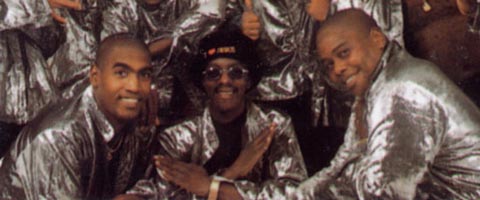
JC Gonzaléz con Victor "Vitis Man" Sagarra y Pedro Pablo Gutiérrez
En estas temporadas que hicimos en Montecarlo, a veces pedían reforzar la cuerda de metales para la parte bailable, y tuvimos varios trompetistas y saxofonistas adicionales, pero que no formaban parte de la agrupación.
Al año siguiente David Calzado asume la dirección de este proyecto, y es cuando yo le propongo cambiar el estilo, y hacer música popular bailable en lugar de música tradicional. Como me había desarrollado en el mundo del jazz, tenía la inquietud de hacer música cubana, pero diferente de la que se hacía hasta ese momento, y me aparecí en un ensayo con el primer arreglo de la nueva Charanga Habanera, fijando estilo y sonoridad. El tema se llama “Tú estás ahí ”, del compositor Reinaldo Fernández Pavón. El formato que teníamos era:
--3 violines ( David Calzado, Pedro Fajardo y Joaquín Peláez)
--cello (Pedro Pablo Gutiérrez)
--flauta y saxofón (Jorge Emilio Maza)
--piano (José Picayo) --bajo ( Luis Quiñones) --trompeta (Victorino Patterson) --viola y paila ( yo) --congas ( Humberto Pérez Medina, conocido como Puchilán, que era el administrador) Al concebir este nuevo estilo, hubo necesidad de cambiar la plantilla de la agrupación, y rejuvenecer 2 de sus plazas.Yo sustituí al maestro Picayo, y hubo que buscar un verdadero pailista. El puesto fue ocupado por Eduardo Lazaga, quien es hijo de un músico cubano de renombre. Nuestro nuevo pailista se convirtió en muy poco tiempo en un prestigioso percusionsta, debido a sus habilidades como instrumentista, y por su originalidad. Se eliminó uno de los violines (Joaquín), y el cello, pasando Pedro Pablo a ocupar la plaza de bajista. Puchilán fue suistituido por Víctor Sagarra, conocido como “El Vitis Man”. Y se aumentó definitivamente un metal, que fue Leonel Polledo en la trompeta. Nuestro primer cantante sa llamó Luis Alberto Leyva, llamado cariñosamente por todos “Empanada”, y nos fue de gran utilidad, pues además de cantante,es muy buen compositor. Haciendo esta nueva música, con “swing moderno”, apareció una gira a Chile, donde estuvimos un mes actuando por invitación del grupo Intillimani, combinando la música tradicional, el latin jazz, la música popular bailable y la música folklórica. Luis Alberto compuso la mayoría de los temas que tocábamos en esta temporada. Al regresar a Cuba, comenzamos a hacer el segundo show del cabaret Caribe, junto a bailarinas de Tropicana, por invitación de Santiago Alfonso (director de Tropicana), y bajo su propia dirección. Es en esta temporada donde se suma Orlando Leyva, el bongosero, primeramente por su juventud y sus capacidades como gimnasta y bailarín, siendo estas ampliamente explotadas en la proyección escénica del grupo. Yo resulté ser una especie de director musical, ya que además de ser el músico de mayor nivel académico, era el único capaz de crear, ya que el jazz me dió la suerte de desarrollar un mundo interno ampilo y flexible. Decidí romper esquemas y no ser una copia de las orquestas ya establecidas, como todas las copias tristes que llenaban el espectro musical de la isla. Mi patrón al concebir este nuevo estilo fue la impresión que me causaron las bandas americanas que vi trabajar en Mónaco, como “Cool and the gang” ; “Blood sweat and tears” ; y « Earth wind and fire », que aunque no la ví, era mi preferida, y de ahí nació el swing « charanguero ». David Calzado, que es un estratega natural, hijo de un cantante estelar, y habiendo trabajado previamente con la “Ritmo Oriental”, orquesta que fue muy famosa en Cuba, y pionera del concepto de espectáculo, creó entre otras cosas, un trabajo corerográfico en el grupo. Su admiración por el inolvidable Benny Moré, mas su previa experiencia, lo llevaron a trazar estrategias que debíamos seguir en el camino hacia el éxito. Escogía los temas con un olfato inequívoco, los vestuarios, y la proyección escénica, lo que lo hace ser un director muy especial. David ha desarrollado un instinto inigualable para conducir al éxito. Incorporamos ciertos cambios en la música bailable, por ejemplo, tomé de base la clave del guaguancó, para asumir su carácter libre y espontáneo. Jugaba con los cambios de acentos agógicos, tanto en el diseño del tumbao del bajo como en el del piano, y el del teclado, creando el “contratumbao”, que es una especie de tumbao que completa desde el teclado el tumbao que está haciendo el piano. Esto lo empecé imitando motivos de la guitarra funk, y lo fui desarrollando hasta complementar mi propio tumbao.También tuve la idea, apoyado por David, de mezclar la música cubana con elementos del rap y del hip hop. Así mismo, cambiamos la célula rítmica tradicional, por ejemplo, el campaneo del bongosero, que dejó de ser el archiconocido para tener un cierto protagonismo dentro del tejido rítmico, según mi idea. De igual forma, introduje la célula característica del bajo y el bombo a dos negras en el tercero y cuarto tiempo del compás, idea que Lazaga y Vitico se encargaron de desarrollar, creando una célula rítmica característica de la orquesta que ha sido muy imitada desde entonces. En mi trabajo como pianista, empecé a revolucionar el tumbao tradicional a partir de los cambios que hizo Rodolfo Argudín (Peruchín), de “NG la banda”, que le introdujo tensiones y movió las síncopas, enriqueciéndolos armónicamente, pero yo creé un idioma diferente donde los tumbaos tienen vida propia.A veces están basados en un pequeño motivo que se repite, o quizás una frase que responde al bajo, que también escribo para que el tumbao tenga congruencia. Hasta este momento los tumbaos seguían siendo como hace 50 años, repetitivos y aburridos, y ahora se crean, para mi regocijo, según mis patrones. Por estos tiempos, 1991, 1992, seguimos trabajando en el cabaret « Caribe », y apareció Juan Manuel Arranz, primo de David, que fue de invitado a un programa de la TV donde yo hacía un solo con la viola, y después me hizo una suplencia por una semana, y cuando yo regresé se quedó compartiendo conmigo algunos temas en el piano y el teclado, pero nunca fue el pianista, sino el tecladista. Se fue “Empanada” de la orquesta, y se incluye entonces a Mario Antonio Jiménez, ”Sombrilla” primero como suplente, pues era muy joven , pero no aparecía un cantante maduro que tuviera la tesitura tan aguda de Luis Alberto. Al poco tiempo llegó también Leucidio Vera, o Leo, como todos lo conocen. Y con este formato , en 1993, grabamos el disco “ Fiebre de amor”, en la EGREM. Concluyó el contrato con Montecarlo, y se nos ofreció la oportunidad de este primer CD, a pesar de ser esta una casa disquera sin muchos recursos técnicos.El disco fue grabado por Antonio López, quien después se convertiría en manager de la agrupación. Yo participé en la mezcla, ya que la Charanga partió hacia Galicia, España, a una gira de la que no participé por haber sido invitado a trabajar en Mónaco con la agrupación “Cha cha chá cuban boys”. Este CD nació en ensayos vespertinos en el Caribe, donde Giraldo Piloto nos cedió el tema que le da título,y el arreglo tiene la línea melódica de David, y la progresión armónica mía, junto a los mambos de los metales, donde traté de copiar el estilo de “Earth wind and fire”, y su vital utilización de los unísonos.David compuso también las guías de los cantantes. Mis arreglos para este disco fueron “Felicidad”, “Para el llanto”, y “Te necesito”, que además es de mi autoría, y a excepción del tema “Crisis de amor”, creé todos los mambos, aunque no sean arreglos míos. Juan Manuel Arranz, o Manolito, fue el otro arreglista de este CD, y tocó el piano en los temas “Pregón del chocolate”, que es un arreglo suyo; y en “Crisis de amor”. Esta primera grabación tiene temas de compositores como Giraldo Piloto (“Me sube la fiebre”), Leonel Limonta (“Extraños ateos”), Issac Delgado (“El pregón del chocolate”), y Manuel González, más conocido como Manolín, el médico de la salsa (“Te la voy a liquidar”, “Para el llanto”), que hicieron posible el éxito que alcanzamos con esta producción discográfica, ya que los temas se hicieron hits uno detrás del otro, y el tema de Piloto recorrió Cuba como una emorragia, en boca de niños, ancianos, jóvenes, adolescentes y adultos. La isla le abrió su corazón a la timba por primera vez de forma apasionada, y nosotros, por ser la banda más joven y “fashion”, logramos colocarnos en las plazas consagradas de la timba en el país.Aún trabajábamos en el Caribe del hotel Habana Libre, cuando empezamos a ser centro de atención de las figuras consagradas de la música como José Luis Cortés, Gonzalo Rubalcaba, Issac Delgado, Los Papines, y otros a los que se sumaron muchos otros. Eramos el suceso musical del momento. En medio de toda esta ebullición, aparece Francis Cabezas con su nueva casa discográfica, Magic Music. Corría el año 1994, y tenía pocos meses de grabada nuestra obra prima. Esta nueva disquera necesitaba jóvenes talentos. Al conocer el trabajo “charanguero”, nos propone grabar un nuevo disco. A pesar de no tener temas suficientes para una nueva grabación, David estimó que este negocio no se podía desaprovechar, porque lograríamos una mejor calidad de grabación, con recursos técnicos superiores. Hicimos las maletas y partimos con destino Barcelona. Resultado: el segundo disco de la Charanga Habanera, titulado “Hey you, loca”. Para este nuevo disco, escribí nuevos arreglos , los de los temas “Quítate el disfraz”; “ Hey you, loca”; “ Tremenda atmósfera”; “Verbo del amor”; “Pelirroja”; y “Placer de amar”. Y repetíamos temas del primer disco, pensando que este nunca iba a tener alcance internacional. Sufrí una gran desilusión con este disco, porque en los créditos no se especifica arreglista, sólo el término de “ Dirección musical: David Calzado”. No obstante, fue un disco con gran aceptación, y fue el lanzamiento mundial de la orquesta, con nuestro estilo timbero, e hicimos varias giras europeas, trabajando en grandes festivales de toda Europa, estuvimos una temporada en Antena 3 de la Televisión Española, y alternamos con grandes figuras como Tito Puente, en Finlandia. Esta fue una época gloriosa, protagonizada por Leo y Sombrilla, y en Cuba, teníamos miles de seguidores, miles de fans, que abarrotaban los lugares donde nos presentábamos, seguidores sedientos de nuestra música, y fanáticos a nuestro concpto “charanguero”, a nuestra forma de vestir, a nuestros bailes, a todo. Justo en este punto, año 1995, se nos va Leo para la orquesta Irakere del maestro Chucho Valdés, en plena explotación del disco. Se nos vino encima un fracaso irremediable, pues el tema “ Mi estrella” de G.Piloto estaba en el #1 del hit parade de La Habana. De corre corre apareció Michel Maza Márquez, siendo un niño, que nos salvó de esta catástrofe. Leonel Limonta, que se encontraba trabajando en el staff técnico de la banda, le compuso el tema “Nube pasajera”, que corrió como la pólvora y lo lanzó a la fama. Este arreglo tiene la línea armónica mía, y todo lo demás es de David. A pesar del éxito que alcanzó Michel, David buscó otro cantante, otra voz joven para que apoyara el trabajo del “Menor de la salsa”. Este fue Joel Barz, que estuvo muy poco tiempo en el grupo, cantando un tema mío que se llama “Se te acabó la magia”, pero su trabajo no fue muy efectivo. Después del disco “Pa´que se entere La Habana”, no continuó trabajando con nosotros, y en esa grabación sólo puso coros. Este disco data del año 1996, y fue el trampolín de Michel al mercado internacional. Y se hicieron ciertos cambios, quizás imperceptibles para el público. El cambio de concepción fue sustancial, desde todo punto de vista, para mejor? Según el punto de vista con que se mire. El formato sufrió un cambio, eliminándose los violines, que habían estado en los dos primeros discos, revistiendo la armonía con contracantos dulces o incisivos; y se introdujo otro metal, una trompeta lead, para apoyar los agudos. El nuevo miembro fue Osmil Monzón. Este cambio endureció la sonoridad, y por supuesto, varió el estilo, dando pasos hacia la música “más de pueblo”, lo cual no es criticable, pero en cualquier caso, tampoco aplaudible. Empezamos a hacer música más simple, o menos cargada, y creamos un falso acercamiento al pueblo en cuanto a idioma, lo que hizo que frases totalmente mundanas que nos resultaban simpáticas en un principio, se arraigaran tanto en nuestros textos que llegó a ser algo lamentable. Los temas comenzaban sólo con un tumbao, de piano o de bajo, y pasamos de orquesta revolucionaria a la categoría de orquesta bailable. Todos estos cambios, a pesar de no ser del todo positivos, fueron muy bien aceptados por el público, y por todos los grupos, los de nueva creación y los ya establecidos, que de inmediato adoptaron nuestras técnicas. “Pa´que se entere La Habana” se grabó en Costa Rica, en los estudios Marsol. Este disco tiene varios arreglos de David y de Manolito, y el arreglo del tema “Dime A” es mío, a pesar de haber salido con el nombre de David, por problemas técnicos en la impresión de las portadas, según me dijeron. Coincidentemente en este año firmamos un contrato con la compañía inglesa Ronnie Scott, con la que estaban trabajando orquestas tan importantes como Los Van Van e Irakere. Este contrato nos garantizaba giras de 1 o 2 meses por toda Europa, trabajando en plazas y festivales muy importantes, pero los salarios no aumentaban, y nos agobiaba una crisis económica. El más afectado fue Eduardo Lazaga, quien no soportó más un salario estático, y se fue de la orquesta. Fue sustituido por Gilberto Moreaux, excelente pailista. A pesar de los problemas económicos, fue un tiempo este muy bonito, lleno de fans europeos que seguían nuestras giras. Para mí esto era lo más importante, ver multitudes bailando con el producto de mi talento musical, y mi creación, después de haberle dedicado noches de desvelo a cada idea. David buscó en el año siguiente (!997), otro cantante, Danny Lozada, nutriéndonos de su fertilidad como compositor , ya que varios de los temas del disco “Disparo a la mirada” son de su autoría, temas que alcanzaron éxito rotundo. Este disco de 1997 fue mi despedida de la Charanga, entre otras razones, porque nunca se hizo pública mi labor dentro del grupo, y la situación económica me disgustaba ya en demasía. A pesar de que sabía que sin mí no iba a sonar igual, porque David no podía buscar un pianista y un arreglista que pensara igual que yo, aunque imitara mi estilo propio, resolví no seguir aguantando situaciones desagradables y sacrificarlo todo. El disco se grabó en La Habana, y esta fue mi última grabación.A pesar de que se publicó una foto mía en la carátula del disco, y sale mi nombre en el arreglo del tema “No estamos locos”, nunca se reveló públicamente todo mi trabajo en la Charanga y para la Charanga. Son estas , y no otras, las razones que me llevaron a separarme del producto que creé. No salí de la orquesta huyendo de la famosa sanción como muchos piensan. Finalmente, pienso que el éxito de la Charanga Habanera, que se atribuyó en un principio a las coreografías y la forma de vestir, realmente está en que coincidió con un despertar de la música cubana, que llegó con la fuerza desvastadora de la vanguardia, rompiendo esquemas en cuanto a formas y estructuras, e innovando, por supuesto influenciado por otros géneros musicales vivos de estos tiempos. [a ser continuada]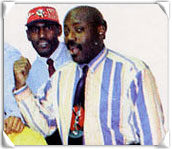
con Leonel Polledo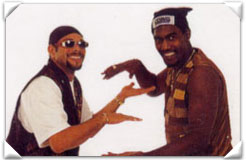
con Manuel "Manolito" Arranz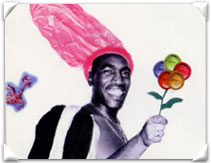
"Tremendo delirio", 1997



















